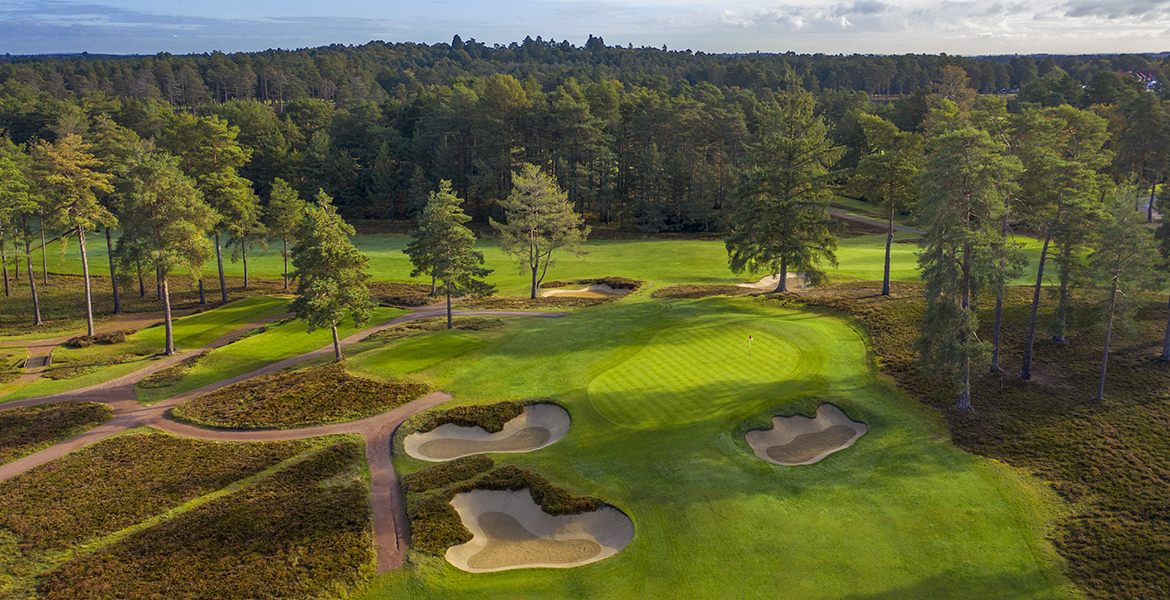Cabot Citrus Farms—the first U.S. property in the Cabot Collection of resort-style communities—is a tasty treat that redefines the idea of golf-home ownership
The easiest way to begin describing Cabot Citrus Farms is to tell you what it isn’t.

It isn’t Florida. That is, not the Florida we think we know. Located about an hour north of Tampa and 90 minutes west of Orlando, it is neither Gold Coast nor Gulf Coast, but a geographic anomaly of rolling terrain punctuated by dramatic elevation changes, 100-year-old oaks dripping with Spanish moss, and no fumes or noise from a nearby interstate.
It also isn’t your traditional golf community. The current real estate available on property—a handful of two- and four-bed-room Cottages side-by-side in a village-like setting—are designed as vacation homes, already furnished and perfect for a weekend here, a week there, enjoying what management calls “a resort experience” when on site. The rest of the time, the Cottages can be put in a rental pool, allowing outsiders to enjoy the amenities.
And one final thing: It’s just the beginning.

Cabot Citrus Farms is the first U.S. outpost of The Cabot Collection, one of the hottest brands in golf today. The company announced itself a dozen years ago with its original course, Cabot Links on Nova Scotia’s remote Cape Breton Island, which very quickly ranked among the world’s top layouts.
Since then, the collection’s growth has been firm and fast: adding a second Nova Scotia course, Cabot Cliffs—designed by Coore & Crenshaw and garnering an even higher world ranking—and renaming the property Cabot Cape Breton; recently opening another Coore/Crenshaw stunner at Cabot Saint Lucia in the Caribbean; taking over Scotland’s world-renowned Castle Stuart course, rebranding it Cabot Highlands, and planning to debut the Tom Doak-designed Old Petty later this year; opening Cabot Revelstoke in the Canadian Rockies; taking on a Continental Europe top 100 in the wine country of France and relabeling it Cabot Bordeaux; and, most recently, announcing a partnership with Lofoten Links, the top-100 course on a remote island off Norway.
Mentioning Cabot’s other properties is significant for reasons beyond demonstrating the company’s good taste and business acumen: They show Cabot’s commitment to providing not just good, but globally great golf at all of its communities.

“We’ve been known for world-class golf since the beginning with Cape Breton,” explains Ben Cowan-Dewar, Co-Founder and CEO of The Cabot Collection. “For so many, that’s their association with the brand, it’s incumbent on us to get that right. At Cabot Citrus Farms, opening with 36 holes plus two short courses, it feels like we did.”
Golf is not new to Cabot Citrus Farms. Before Cabot bought it in 2021 and began a top-to-bottom makeover, it was known as World Woods, which opened in the early 1990s with two Tom Fazio courses, a huge circular driving range, short course, and other golf amenities. But no accommodations and minimal dining options.
When Cabot Citrus Farms debuted in early 2023, it did so with both a great number—57—and a great variety of golf holes, plus the first neighborhood of Cottages, numerous places to eat and drink, a few other outdoor activities, and a multi-year plan for development that is well under way.
True to the Cabot model, golf is first, foremost—and fabulous.

The two 18-hole courses—Karoo (the call of the sandhill crane that is prevalent in these parts) and Roost (native wild turkeys make their home in the oak trees)—sit on the same land the World Woods courses did, but that’s where any similarity ends. New architects brought new ideas, including all-new routings, widening the playing fields, and opening up the vistas so the land’s tossing, turning, and topography are revealed in full panorama.
Karoo is the work of architect Kyle Franz, who took to heart Cowan-Dewar’s encouragement to be “really creative.” Inspired by the idiosyncrasies of classics like the Old Course and National Golf Links, he connected fairways as well as greens, even hazards, and fashioned wide, rolling fairways that merge with big sandy waste areas and offer a choice of angles into undulating greens. Franz has also said he was inspired by Riviera-designer George Thomas’s “course within a course” concept, in which moving the tees from day to day produces very different experiences.
Karoo is all that and more, with a healthy helping of fun aided by the propensity of the turf to play fast and add roll. That was tested last fall when two hurricanes came close enough to flood fairways; the sandy base allowed the course to open again in just a couple of days.

Roost cozies up to Karoo in a few spots, but for the most part these siblings couldn’t be more different. Most of Roost—a collaboration of architects Franz, Mike Nuzzo, and Rod Whitman (of Cabot Links fame), with consultant Ran Morrissett—draws on a different set of seminal layouts, notably Augusta National and those in the Australian Sandbelt. This is made possible by a 100-mile-long ridge, created in prehistoric times by the movement of glaciers and ocean, that runs through central Florida and bisects Cabot Citrus Farms.
As a result, the soil beneath Roost is less sand and more dirt, the vegetation everything from wildflowers and dogwoods to corridors of stately oaks. The spirit of Alister MacKenzie inhabits the Augusta-like bunkers and the challengingly undulating greens Whitman shaped.
For their pronounced differences, the two courses share an important characteristic: they’re very walker friendly, and like all Cabot properties, provide top-notch caddies. Walking—without caddies but with friends, family, a single club, drink in hand, no shoes, or just about any other way you can imagine—is also the hallmark of the two short courses, The Squeeze and The Wedge. (The names follow the citrus theme and are reflected in colorful, creative logos that reflect a casual attitude aptly described as “Cabot cool.”)

The Squeeze is Nuzzo’s nine-plus-a-bonus-hole, there-are-no-rules project, with a big par five, a teeny par three, drivable par fours, and everything in between, sprinkled with funky greens and surprisingly rich in strategy. As they say, it will test everything you’ve got, while making you giggle like a kid. You’ll quickly want to play it again.
Next door is The Wedge, 11 par threes that try to fit in all the features Nuzzo used so cleverly on Karoo—big sandy waste areas, hanging lies, and slippery greens—plus the sound of music from speakers around the course. Try it with just a putter, in bare feet, with your kids or grandkids, definitely with a drink or two, even at night, as it is lit for night play.
Also enjoyable after dark is the 2.2-acre putting course, called The Tangerine, and the 20-station driving range, where each bay is outfitted with a Trackman screen. More music (classic rock to country), comfy cushioned chairs, and signature “Cabot couches” at each station reinforce the chill vibe.

For at least the next year, golf will provide most of the on-site entertainment. But there’s also surprisingly good fishing: Director of Recreation Tyler Ramsdell is expecting a state-record largemouth bass to be hauled out any day, and he has plans to selectively stock the lakes to ensure anglers’ success. He also manages the Cabot Sporting Club, which currently includes a 5-stand for shooting, plus stations for archery and axe-throwing, which is a hoot (and not just because I hit the target on my first toss).
True to the Cabot model, golf is first, foremost—and fabulous. New architects brought new ideas, including all-new routings, widening the playing fields, and opening up the vistas so the land’s tossing, turning, and topography are revealed in full panorama.
Ramsdell’s next big project is carving miles of trails for hiking and biking (including electrics) through the 600-plus acres of forest. I’m no expert on the Sunshine State, but stomping through the brush and trees, looking for turkey, deer, even bear, and spotting the orange trees that lend their name to the property sure didn’t give the impression that we were afoot in Florida.
Construction has begun on the Pool Club and Racquets Courts (tennis, pickleball, padel), a full-service wellness center and spa, and a clubhouse, all planned to open in early 2026. That will be Citrus Farms’s “aha moment,” and also the unveiling of additional real estate, including more Cottages as well as two-story Fairway Homes—tucked back in the trees but almost invisible from the golf course—for those looking for a little more room and a little more privacy. (The homes also can go into the rental pool.)
Among the features of the new clubhouse will be a 250-seat restaurant, but there’s plenty of good food and drink already being served. Karoo and Roost have their own comfort stations, which golfers pass three or four times a round: Besides the usual fare are local specialties like a crawfish roll, hot dog with pimento, and chicken ‘n’ waffle. Each also has a bar, a selection of Cabot cocktails, and a choice of four canned alcoholic drinks named for the four courses (Wedge is a smoked blood orange margarita, Roost a spiced tropical punch with rum, and so on).

For tequila and Mexican fare, it’s a quick walk—and everything is just steps away—to Cantina, located along The Wedge course. But the highlight for me was The Porch, which sits on a little hill overlooking both short courses, with comfy seating, a broad choice of bourbons and other spirits, a smoker, a pizza oven, and incredible sunsets. It’s the perfect place to assemble as the day winds down, loll, sip, snack, and throw smack at the golfers below.
The next dining option should be opening just around now. Called Grange Hall, it’s a barn-like building in the village that will serve largely farm-to-table fare, with local produce and beef (you’re very likely to pass cattle farms no matter where you drive in from). Seating about 120 in a big open space, with some outdoor spillover, Grange Hall will be the first big food facility on site, providing a real community gathering place as well as the customer research that will help craft future menus.
Anyone serious about dining should ask for a meal cooked in their cottage. A team of chefs and servers comes to the residence and works magic in the well-appointed kitchens. Our six-course feast—with at least six wines to match—ranged from octopus to a corn chowder zesty with chili oil, grouper to beef medallion. Not only an outstanding meal, it perfectly fits the Cabot philosophy of offering golfers something more than they can get in a hotel.

As the first Cabot property in the U.S.—and so close to two major airports—Cabot Citrus Farms will likely be the principal gateway for many into the collection. Right now, both the golf and the Cottages are available to all, while the first tranche of residences is being snapped up by those who want to get in early, bring in their friends, play some terrific golf, and watch things develop. The two-bedroom Cottages start at $1.675 million, four-bedroom at $2.970 million, fully furnished. Fairway Homes start at $3.325 million.






